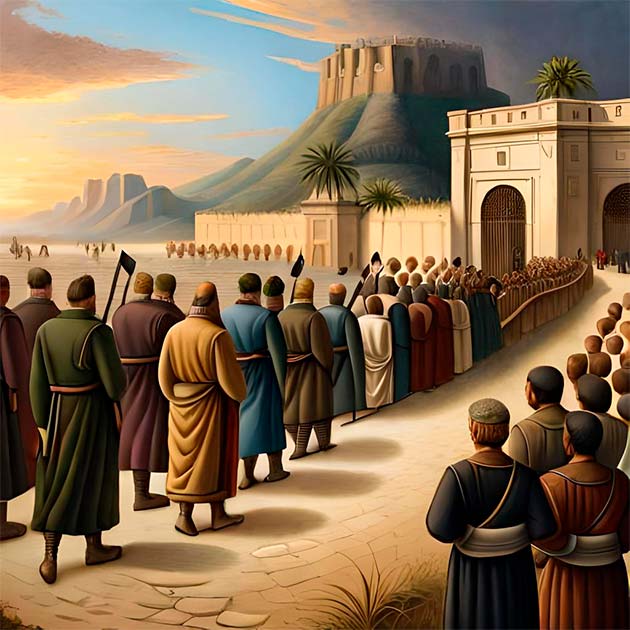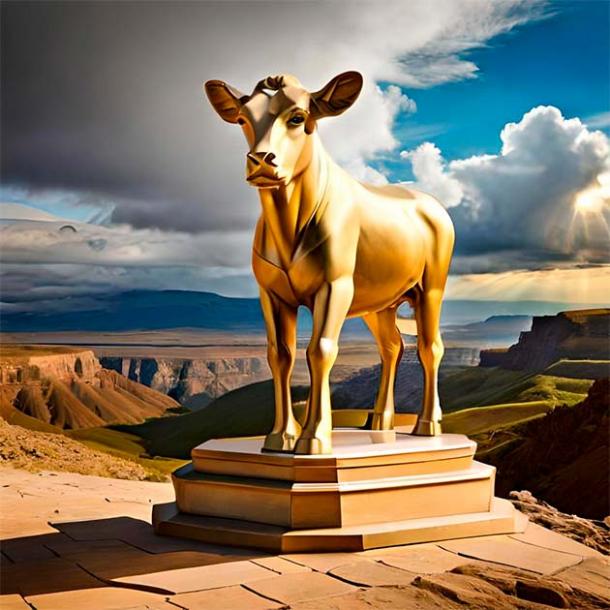The Legend of Sambation River and the Ten Lost Tribes of Israel
Deep within the realms of ancient Jewish folklore lies a tale of intrigue and mystery surrounding the Ten Lost Tribes of Israel and their elusive barrier, the Sambation River. This mythical watercourse has captivated imaginations for centuries, sparking questions about its existence and the fate of the tribes it is said to have protected. In this exploration, we delve into the enigmatic nature of the Sambation River and the enduring mystery of the Ten Lost Tribes.

Stories about Sambation River are legendary, linked to the mythology surrounding the Ten Lost Tribes of Israel. (AI Generated / Anath Genomic Consultants AB)
The Legend of Sambation River
The legend of the Sambation River is believed to be over 2,000 years old, or possibly more, and it has undergone numerous revisions since it was first described in the first century AD. This legendary river is mentioned in various cultures and Jewish writings, and it is a fusion of different tales that developed independently.
According to ancient Jewish texts, the Sambation River was no ordinary waterway. It was described as a river that roared with tremendous force, making it seemingly impossible to cross. Legends spoke of the deafening noise caused by the river’s violent currents, which carried heavy stones that obstructed any attempt to traverse its mighty waters.
The river’s very name, Sambation, derived from the Hebrew word Shabbat (Sabbath), alluded to a peculiar phenomenon—the river’s stillness and cessation of its raging torrent on the Sabbath day, the single day that Jews cannot pass it.

According to Jewish folklore, the Sambation River would cease its tumultuous flow on the Sabbath day, allowing for temporary passage across the river on that specific day. (AI Generated / Anath Genomic Consultants AB)
Searching for the Ten Lost Tribes of Israel
The Ten Lost Tribes of Israel, exiled by the Assyrians in the eighth century BC, have become the subject of countless speculations and quests for their whereabouts. Ancient stories place these tribes near the Sambation River, isolated from the rest of the world. But which tribes were those? Did they truly vanish? Were they obliterated or assimilated? Or do their descendants still exist, hidden from modern view?
According to one story, the Levites or Sons of Moses are the ones blocked by the river, whereas Judah and Benjamin were scattered among the nations. In this version of events, God showed the Levites the way to the river for their protection and sealed the path behind them so that no one could find them. Meanwhile, a burning fire shielded the Levites from outsiders when the river was calm.
The story told by Eldad Hadeni is slightly different; there, a mystic cloud hides the Levites on Saturday. A similar account exists in Islamic sources, which might parallel Jewish sources that did not survive. The problem with these stories is that it is difficult to accept that the Levites were separated from the Israelites and the Judaeans.
The Bible states that the Levites mixed with the Judaeans and shared their exile to Babylon; they may not have been exiled with the Ten Israelite Tribes. Although the Levites lived in all the major cities in the Israelite territories, King Jeroboam appointed priests who were not Levites. Consequently, the Levites joined the Judaeans.

The Ten Lost Tribes of Israel, exiled by the Assyrians in the eighth century BC, have become the subject of speculation. (AI Generated / Anath Genomic Consultants AB)
By the 6th century AD, Jewish sources all agreed that the ones blocked by the Samation River were the Ten Lost Tribes. The Islamic sources of that time continued to depict a large group descended from Moses who did not commit the Sin of the Golden Calf (ie. worshipping a false god/idol), which earned them divine protection. Other versions did not focus on that particular sin but described the group as virtually righteous, allowing the expansion of this group to include the Lost Ten Tribes in later sources.

In the Jewish faith, the Sin of the Golden Calf was the Israelites' act of idolatry, worshipping a false god, which violated God's commandments. (AI Generated/ Anath Genomic Consultants AB)
Searching for the True Location of Sambation River
Numerous questions continue to shroud the Ten Lost Tribes and the Sambation River. One key aspect is the location of the river itself. Scholars and explorers have sought to uncover its exact whereabouts, with proposed sites ranging from the usual suspect (Mesopotamia) to China.
Other attempts have placed Sambation River in Armenia, where an ancient kingdom was situated in the eastern part of Anatolia and the southern Caucasus region, Central Asia (specifically Kazakhstan or Turkmenistan), and Transoxiana (a historical region encompassing parts of modern-day Uzbekistan, Tajikistan, and Turkmenistan).
A no less intriguing question is how did the river disappear from the geographical books? However, thus far, no tangible evidence has emerged. The absence of concrete geographical markers has allowed the legend to endure and the phenomenon of a river that rests only on Sabbath continued to be told.
- Seeking The Ten Lost Tribes Of Israel, Finding DNA
- The Levites and the Kohens: The Patriarchal High Priests of Judaism
In the 17th century, Rav Menashe ben-Israel of Amsterdam (1604-1657) recounted a story from his father in his book, Sefer Mikveh Yisrael. The story detailed a unique “hack” used by converso Jews to determine the arrival of Shabbath.
According to the tale, a black gentile would walk through the streets of Lisbon late on Friday afternoon, carrying a glass vessel filled with jumping sand and stones. The water and stone sample was obtained from the Sambation. When the Jews witnessed this Sambation-bell, they knew that Shabbath was approaching and would close their shops.
Much like the river, the fate of the Ten Lost Tribes of Israel remains a matter of speculation. Did they stay isolated near the Sambation River, preserving their unique identity and customs? Or did they integrate into neighboring societies, leaving no trace of their distinct heritage? The answers to these questions lie hidden within the annals of history, waiting for discovery.

Biblical Israelites and Jdeans. (Ancient Origins / Anath Genomic Consultants AB)
The Hunt for the Ten Lost Tribes of Israel Continues
In recent times, scientific advancements, particularly in genetics and DNA analysis, have sparked hopes of shedding light on the mystery of the Ten Lost Tribes. Genetic studies offer the potential to trace ancestral lineages and detect connections to specific regions or populations. However, these endeavors face substantial challenges due to the complex interplay of historical migrations, genetic mixing and the passage of time. Despite the allure of using science to unravel the enigma, the journey toward uncovering the truth remains ongoing.
Would you like to learn if you are related to the Israelites and the Ten Lost Tribes? In Ancient DNA Origins, we developed DNA tests for each one of the tribes. Each test compares uses to the DNA of ancient individuals of the Israelite tribes. The ancient DNAs were obtained from skeletons found in Israel before the exile and, with the help of AI, reconstructed the genome of the ancient Israelites, allowing us to calculate just how genetically similar they are to modern individuals. With this test, we can trace the whereabouts of the Ten Tribes.
Top image: Representational AI generated image of Sambation River. Source: Tech Hendra / Adobe Stock


















Comments
How can we find our paternal lineage since we have no Y chronometer?